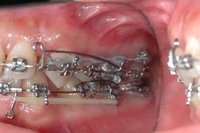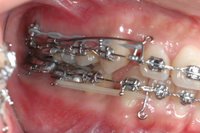The Mini-Screw as an Orthodontic Anchoring
 The use of osseointegrated implants and mini implants has become a valid alternative to those methods normally employed to manage anchorage in modern orthodontics. Most clinical procedures aimed at providing adequate anchorage require patient co-operation, some degree of discomfort as well as prolonged chair time for the orthodontist. Over the last few
The use of osseointegrated implants and mini implants has become a valid alternative to those methods normally employed to manage anchorage in modern orthodontics. Most clinical procedures aimed at providing adequate anchorage require patient co-operation, some degree of discomfort as well as prolonged chair time for the orthodontist. Over the last few  years though, a great deal of experience has been gained regarding the use of Mini Implants to obtain bone anchorage and this particular therapeutic optionhas proved to be extremely reliable and stable. In recent times, osseointegrated dental implants have been used for orthodontic anchorage; these however have turned out to present the Orthodontist with some disadvantages:the difficulty of choosing the right implant positioning in individual patients, the necessity of waiting for osseointegration to occur before any force can succesfully be applied, an extremely invasive removal procedure and, last but not least,excessive costs involved. The
years though, a great deal of experience has been gained regarding the use of Mini Implants to obtain bone anchorage and this particular therapeutic optionhas proved to be extremely reliable and stable. In recent times, osseointegrated dental implants have been used for orthodontic anchorage; these however have turned out to present the Orthodontist with some disadvantages:the difficulty of choosing the right implant positioning in individual patients, the necessity of waiting for osseointegration to occur before any force can succesfully be applied, an extremely invasive removal procedure and, last but not least,excessive costs involved. The
 Mini Screw Implants we use are made of surgical grade stainless steel, therefore they do not require osseointegration to be able to perform. They allow immediate loading and it is extremely easy to remove them. We do however recommend that the Orthodontist allows approximately 2weeks for the soft tissues to heal before any forces areapplied. Mini Implants of reduced diameter are available for insertion in any desired point, including inter-radicular spaces. The main indications for the use of Mini Implants are: 1 – Intra-arch extrusion in the anterior sections; 2 – Intra-arch intrusion in the posterior sections; 3 – Surgical disinclusions; 4 – Orthodontic anchorage after extractions; 5 – Orthodontic anchorage to support distalization
Mini Screw Implants we use are made of surgical grade stainless steel, therefore they do not require osseointegration to be able to perform. They allow immediate loading and it is extremely easy to remove them. We do however recommend that the Orthodontist allows approximately 2weeks for the soft tissues to heal before any forces areapplied. Mini Implants of reduced diameter are available for insertion in any desired point, including inter-radicular spaces. The main indications for the use of Mini Implants are: 1 – Intra-arch extrusion in the anterior sections; 2 – Intra-arch intrusion in the posterior sections; 3 – Surgical disinclusions; 4 – Orthodontic anchorage after extractions; 5 – Orthodontic anchorage to support distalization Free PDF Articles about orthodontic mini screw:
1.A Radiographic Evaluation of the Availability of Bone for Placement of Miniscrews
3.Group Distal Movement of Teeth Using Microscrew Implant Anchorage

0 Comments:
Post a Comment
<< Home